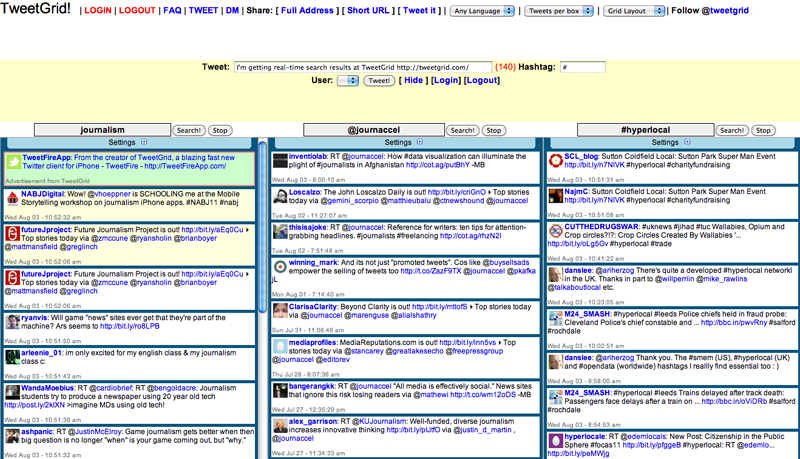Blog:
Tweetup 411: What they are & how they work
 As many publishers are trying to figure out how to get 29 hours out of a 24 hour day, this post offers more context on how others are using Tweetups, and for those unfamiliar with what a Tweetup is, a general overview of how these things work, so you can assess if it may, or may not, add value to your community.
As many publishers are trying to figure out how to get 29 hours out of a 24 hour day, this post offers more context on how others are using Tweetups, and for those unfamiliar with what a Tweetup is, a general overview of how these things work, so you can assess if it may, or may not, add value to your community.

Samantha Clemans gives a Twitter presentation, March 2011. Photo by John Coghlan.
By now, if you are on Twitter, you have probably heard about, or maybe even joined, a Tweetup. And for the uninitiated, a Tweetup is a “Twitter Meet-up.” These Twitter Meetups can also be called Twitter Parties or a Twitter Chats; basically it’s a set time and date when a group of individuals are on Twitter to discuss a certain set topic.
More commonly, you might have heard that a Tweetup includes meeting with people in person to have a few drinks, network, and talk about a popular topic, all while tweeting. This is indeed still true, however, the lingo often gets blurred. Because an original style Tweetup can take weeks to plan, is costly and limits the amount of participants, many Tweetups have morphed to being solely online endeavors. Check out our resource for tips on how to host a Tweetup or read this post from Mashable for an example of the in-person version of the Tweetup.
Tweetups are held daily and can cover a wide range of topics and formats. You have the “just for fun” Tweetups, like #horsechat by @horsefamilymag that discusses all things horse related; professional Tweetups like this Legal Marketing (and Star Wars themed) Tweetup; and even the White House’s official Twitter chat #whchat.
With all the variations of Tweetups (size, topic, in-person, web only) we thought it would be useful to know why organizations decide to host Tweetups and what’s the benefit of participating in one? More importantly, how might other nonprofits, who are typically on a shoestring budget and running content programs with a limited staff, share the lessons they have learned to inspire ideas to new media news sites trying to make the most of limited resources? Margie Kelly, a seasoned advocate and communications strategist for nonprofits (including Safer Chemicals, Healthy Families), says that Tweetups are a quick way to gain awareness:
Tweetups are a fun and quick way to listen, learn, share resources, and become part of the conversation that matters to you, one tweet at a time. I would recommend including Tweetups as part of the outreach strategy for any organization interested in building community and increasing awareness of its mission.
An interesting example of a nonprofit using Tweetups to reach out to legislators comes from Lindsay Dahl, the Deputy Director at Safer Chemicals, Healthy Families:
Tweetups are an incredibly useful tool to energize the public and spread the word about issues you care about…It is crucially important that we inform and engage the public on contacting their Members of Congress, Tweetups create the space for us to educate and inspire people to act. New forms of media are proving to be incredibly powerful in changing the face of advocacy and reach new and unexpected audiences.
In addition to reaching out to elected officials, there have been other success models for Tweetups. In particular, fundraising events that have brought in thousands of dollars, all through (well advertised) “Twestivals.” Read more from Mashable about the 2009 international water charity Twestival that brought in more than $250,000.
For a number of publishers, like those at the Altadena or Locally Grown Northfield, they see being out in their communities as more critical to their day to day operations.
Griff Wigley of Locally Grown Northfield uses social media, less so for Tweetups but as an essential part of the way he connects with his community. One important point that Griff discusses concerns the need to be clear on the goals that guide a community news site’s purpose. From there, it’s easier to determine if a Tweetup is on strategy, or may rob a publisher of precious time that might be better invested to build the business in other areas.
Blogging on Locally Grown Northfield and facilitating the conversation in the comment threads attached to the posts are my first priority so I don’t take time away from that to engage significantly in conversations/socializing/relationship building in my Locally Grown ‘outposts’ on Facebook, Twitter, and now on Google+.
I’m bigger on using those networks for A) listening/learning; and B) linking to my blog posts, drawing people from them to the blog. For a geographic community, it’s important to me to continually build our archive of both content and conversation that easily be referred/linked to in the years to come. (The archive is now up to 3,300 blog posts and 43,000 comments since 2006.) That’s a rich trove that I continually tap into for our community affairs/issues discussions. If that content and those conversations had taken place instead in Facebook, it wouldn’t be nearly as accessible.
So I’ll continue to experiment with the social networks — doing a Locally Grown Google Huddle is on my to-do list in the next week — but I don’t see that we’ll ever do anything that would detract from the vitality of our blogsite as our anchor.
Tell us, what have you seen and learned? Do you use Tweetups (or Twitter in general) to collaborate with colleagues? Or is there something else we should know about? The Journalism Accelerator community has already helped us compile a great list of journalism related Tweetups and hashtags; check it out and add any others that you see as helpful.











Weigh In: Remember to refresh often to see latest comments!
2 comments so far.
Thank you for this 411. I have watched and participated in a few Tweetups as well, and I love how they are jammed packed with info on specific topics that I care about AND that the time goes by really fast.
I agree. Tweetups are a great way to learn quickly about a new topic.